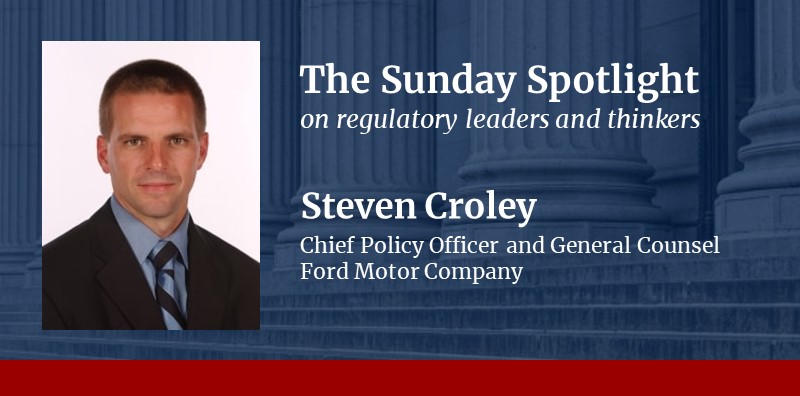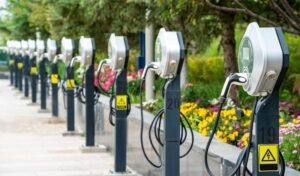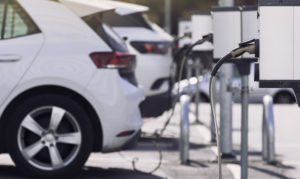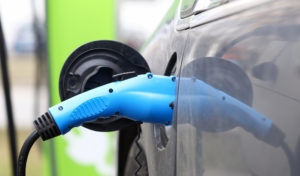
Steven Croley, general counsel of Ford Motor Company, discusses regulatory implications of a shift to electric powered automobiles.
In a discussion with The Regulatory Review, Steven Croley, chief policy officer and general counsel of Ford Motor Company, offers his thoughts on the opportunities and challenges the automotive sector confronts in making a transformation to electric vehicles.
Sales of electric vehicles (EVs) are increasing rapidly all over the world. Statisticians project that the EV market will reach $623.3 billion in 2024 and continue to grow at an annual rate of nearly 10 percent until 2028. Ford Motor Company has committed to helping meet the need for greener vehicles, also pledging itself to achieve carbon neutrality by 2050 and to 100 percent use of local and renewable electricity in its manufacturing by 2035.
Croley explains that the adoption of electric vehicles will provide many consumer benefits in the coming years. He notes, however, that the conversion to a completed electric fleet in the U.S. will be gradual, as no single one-size-fits-all propulsion system exists. Electric vehicle use, according to Croley, will vary depending on consumer needs and market trends.
Croley also notes that government policies, including tax incentives and infrastructure investments, are important to support a general shift toward electric cars. He indicates that public policy will need to support the installation of charging stations to public roads, the domestic production of electric batteries, and the provision of charging access to those living in apartments.
Croley was named Ford’s chief policy officer and general counsel in July 2021. His work includes leadership roles in Ford’s legal, compliance, and environmental policies. Before his tenure with Ford, Croley was a partner in the Washington, D.C., office of Latham & Watkins. There, he assisted clients with legal policy and regulatory compliance, with an emphasis on energy and the environment. In addition, Croley previously served as general counsel for the U.S. Department of Energy and as special assistant to President Barack Obama for regulatory policy and then as Deputy White House Counsel overseeing legal policy.
In addition to his extensive private sector and government work, Croley served as a special assistant U.S. attorney in the Eastern District of Michigan’s Civil Division. He was also a professor, then associate dean, at the University of Michigan Law School. Croley earned a bachelor’s degree from the University of Michigan, a doctorate in government from Princeton University, and a law degree from Yale University.
The Regulatory Review is pleased to share the following interview with Steven Croley.
The Regulatory Review: The automotive industry is shifting its focus toward electric vehicle development. What do you see as the benefits to consumers and society from electric vehicles?
There are so many. Electrified auto transportation will have substantial benefits that protect our climate by reducing carbon and other harmful emissions. That’s one big benefit. But to tell you the truth, those benefits can distract from the other side of it, which is that electric vehicles are really fun to drive. They perform fantastically. They are quiet, so the in-car experience is nicer. Drivers can skip the routine of going to a gas station because the “fuel tank” is full every morning. And maintenance costs are much lower because there are many fewer parts, which is why we are now seeing many commercial customers—who are ruthless about the total costs of ownership and don’t buy working trucks and vans for climate reasons in particular—preferring electric too.
On top of all that, electric vehicles (EVs) can be used to power equipment or even your home. True story: I hooked my F-150 Lightning up to my sump pump when my family lost power for three days last winter. It saved my basement from flooding.
TRR: What are some of the biggest challenges associated with converting the gasoline-powered automobile fleet in the United States to an electricity-powered one?
The conversion is going to be gradual, which is okay. Consumers will decide for themselves what kind of propulsion system makes sense for them. For some duty cycles, EVs are clearly best. For others, internal combustion engines are best. Here is a point that is often overlooked: The choice is not between pure EV and pure internal combustion engine. There are many hybrids on the market, and in the coming years, there will be even more. These will include longer range EVs that have both power systems in them that can get 100 or 150 miles on electricity and then convert to gas.
Charging infrastructure is also a challenge, although this will be overcome. In the early days of the automobile, and not so long ago, people used to carry gas cans full of gas because they were worried they would run out between stations. We are going through that history again, but ultimately this will be solved given the benefits of EVs.
Perhaps the single biggest challenge today is the cost of the battery. We have to push the price of EVs downward, and most of the cost is in the battery. As battery chemistry evolves and the costs come down, the shift to EVs will be rapid for many drivers.
TRR: How is public policy helping to address some of these challenges? What are the current tax incentives or infrastructure policies that are supporting a transition to electric vehicles?
The Inflation Reduction Act’s production and consumer tax credits help some during this transition. The Bipartisan Infrastructure Law also helps some. The government has played a useful role in the transition, as it has for other major transitions such as power production, infrastructure, and telecommunications.
TRR: Are there additional policies that would be helpful?
Permitting reform to hasten domesticating the supply chain EV battery materials would be helpful.
Ultimately, however, auto manufacturers will have to produce vehicles that customers love, and customers will speak with their pocketbooks. But the data suggest continued growth. In the next 4 to 6 years, growth will accelerate.
TRR: Are there any potential environmental downsides to electric vehicles, such as from the sourcing of material for batteries or battery recycling and disposal? What should be done to address these concerns?
I’m not sure about downsides on a relative basis, but there are watch-outs for sure. We must be very vigilant about mining and chemical processing to ensure the environmental and labor integrity of EV supply chains. And we need to take a lifecycle approach to recycling and disposal too. Here, environmental requirements and transparency are essential. That’s just good policy.
TRR: When it comes to making charging stations available and accessible, especially in rural communities, are there state or local regulatory hurdles that need to be overcome?
I don’t think regulatory hurdles are the main obstacle. Some local utilities may need help, as this is a new area to them too. But actually, charging is a bigger challenge in cities with dense populations where customers do not live in single-family homes. At-home charging in rural areas is getting easier and cheaper over time. At-home charging gets you 200 or 300 miles every morning, depending on the EV. Yes, we need public chargers along the highways and roadways too, for extended trips, but that is not difficult to solve. Charging for apartment dwellers is more challenging.
TRR: Going a bit beyond electric vehicles, autonomous car technology is a topic of increasing importance in the automotive industry. What, if any, new regulatory challenges do you foresee with respect to the wider adoption of autonomous vehicles?
Federal motor vehicle standards applicable to full autonomy would be nice. But I don’t think the federal government is going to do that. There is a bit of a chicken-and-egg problem here, which is that safety regulators do not have great insight into the technology for full autonomy and automakers are not sure what regulators will do. There are a host of new questions—or rather new spins on old questions—surrounding insurance, liability, and so on. But the safety benefits of autonomy will be so important that society will navigate through those.
TRR: Just curious: Have you had a chance to drive the electric Mustang Mach-E yet? What is it like?
Yes, the one in my garage. It’s fantastic. I would drive it every day, but my wife usually beats me to it. So, I take the F-150 Lightning instead, which is also a fun vehicle and a smooth ride. Or my Super Duty F-250 when I am pulling something heavy or need extra muscle.



